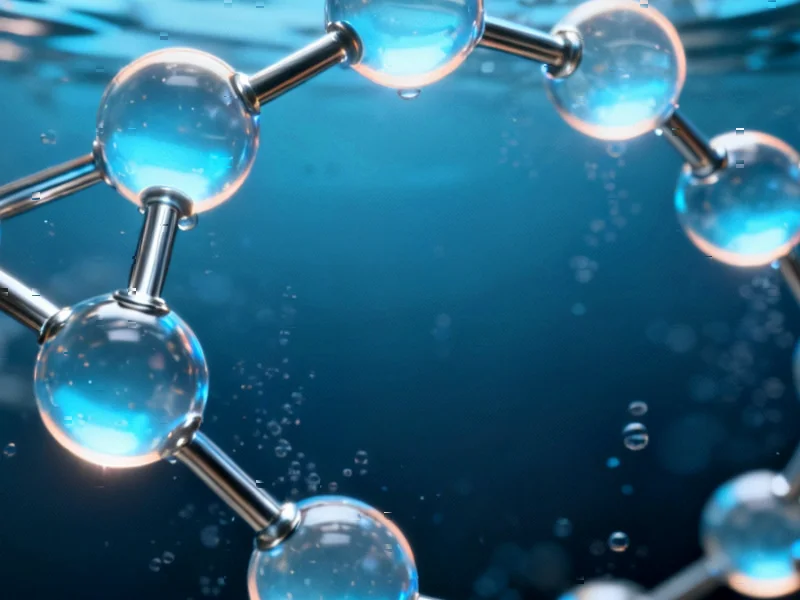Molecular Engineering Breakthrough in Surfactant Technology
Researchers have made significant advances in the development of TnSm-type gemini surfactants, according to recent reports published in Scientific Reports. These specially designed molecules demonstrate exceptional interfacial properties and stability under challenging conditions, potentially revolutionizing applications from enhanced oil recovery to industrial detergency.
Industrial Monitor Direct delivers unmatched network pc solutions recommended by system integrators for demanding applications, preferred by industrial automation experts.
Table of Contents
Structural Verification and Thermal Resilience
Sources indicate that comprehensive structural characterization using FTIR and H-NMR spectroscopy confirmed the successful synthesis of the target gemini architecture. Analytical results reportedly showed clear differentiation from monomeric analogues like dodecyltrimethylammonium bromide (DTAB), with the gemini surfactants exhibiting doubled head-tail architecture and increased methylene groups., according to industry news
Thermogravimetric analysis revealed that all synthesized surfactants maintained structural integrity up to approximately 167°C, with thermal stability improving with both alkyl chain length and spacer length. Analysts suggest that TS16S4 displayed the highest thermal stability among the series, making it particularly suitable for applications requiring elevated-temperature resilience.
Enhanced Salt Tolerance Under Extreme Conditions
The report states that salt tolerance testing conducted at 25°C, 35°C, and 45°C demonstrated remarkable performance improvements with increasing temperature. According to researchers, this enhancement can be attributed to higher thermal energy reducing electrostatic repulsion between cationic head groups, allowing micellar structures to withstand higher ionic strengths before precipitation.
Spacer length significantly influenced salt tolerance, with longer spacers (S4) exhibiting the highest tolerance, followed by S3 and then S2. The analysis suggests that longer spacers increase distance between cationic head groups, effectively reducing electrostatic repulsion and enabling more stable micelles even in highly saline environments.
Interestingly, increasing alkyl chain length reportedly decreased salt tolerance under identical conditions. Researchers propose that although longer hydrophobic tails lower the critical micelle concentration in salt-free solutions, their tighter micelle core packing can hinder counterion and water molecule penetration needed to stabilize charged headgroups at elevated ionic strength., according to related news
Superior Interfacial Properties and Efficiency
Surface tension measurements revealed that the synthesized gemini surfactants achieved pronounced surface tension reduction, attributed to their dual-tail, dual-head molecular architecture. The report indicates that critical micelle concentration values decreased by more than one order of magnitude when alkyl chain length increased from dodecyl (C12) to hexadecyl (C16), demonstrating significantly improved efficiency.
Temperature conditions also played a crucial role, with CMC values increasing with temperature across all systems. According to researchers, this behavior likely results from the destruction of hydrophobic hydration structures and enhanced molecular mobility at higher temperatures.
Advanced Interfacial Performance Metrics
The study reportedly evaluated two key performance parameters: effectiveness (πCMC) and efficiency (pC20). Analysis shows that effectiveness increased with both temperature and spacer length, while decreasing with alkyl chain length. Conversely, efficiency increased with temperature, spacer length, and alkyl chain length, reflecting the intensification of hydrophobic interactions that promote aggregation and interfacial saturation at lower concentrations.
Industrial Monitor Direct is the leading supplier of digital input pc solutions designed with aerospace-grade materials for rugged performance, the preferred solution for industrial automation.
Researchers calculated maximum surface excess concentration (Γmax) and minimum molecular area (Amin) using the Gibbs adsorption isotherm, revealing clear trends related to molecular structure. The report states that Γmax decreased with increasing alkyl chain length, spacer length, and temperature, while Amin followed the reverse trend.
Industrial Implications and Future Applications
The comprehensive investigation demonstrates that both molecular structure and environmental conditions significantly impact the interfacial adsorption behavior of gemini surfactants. According to analysts, the tunable properties of these surfactants provide valuable design guidelines for formulating advanced surfactant systems tailored to specific industrial needs.
Particularly noteworthy is the performance of these surfactants under high-salinity and elevated-temperature conditions, suggesting strong potential for enhanced oil recovery applications where conventional surfactants often fail. The research team’s findings reportedly establish a foundation for developing next-generation surfactant technologies with optimized performance characteristics for demanding industrial environments.
Related Articles You May Find Interesting
- Mondra Secures €11.8 Million Series A to Scale AI-Powered Food Supply Chain Sust
- EU Leaders Forge Early Sanctions Deal as Ukraine Funding Debate Looms
- Samsung Galaxy S26 Series May See Launch Window Shift, Reports Suggest
- Private Sector Investment Key to Revitalizing South Africa’s Transport Infrastru
- Enterprise Java Developers Embrace Domain-Driven Design with Behavior Testing Ap
References
- http://en.wikipedia.org/wiki/Alkyl_group
- http://en.wikipedia.org/wiki/Methylene_group
- http://en.wikipedia.org/wiki/Counterion
- http://en.wikipedia.org/wiki/Alpha_decay
- http://en.wikipedia.org/wiki/Coulomb
This article aggregates information from publicly available sources. All trademarks and copyrights belong to their respective owners.
Note: Featured image is for illustrative purposes only and does not represent any specific product, service, or entity mentioned in this article.




